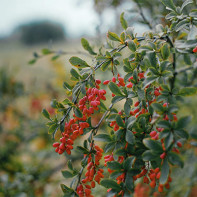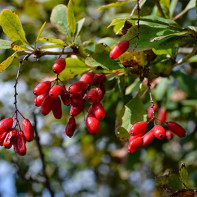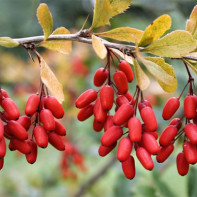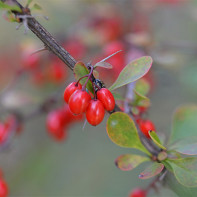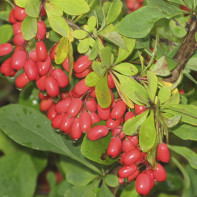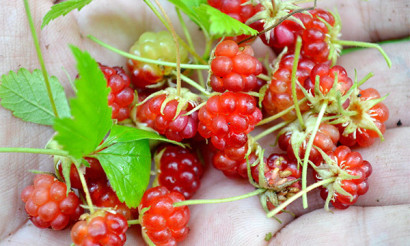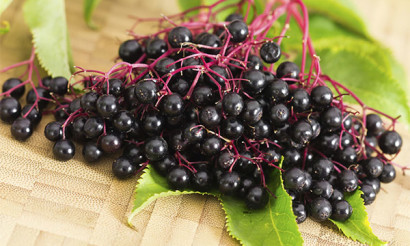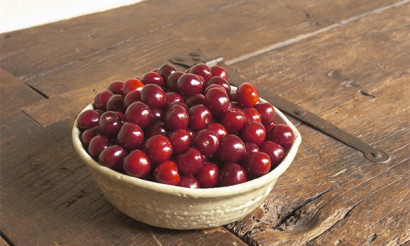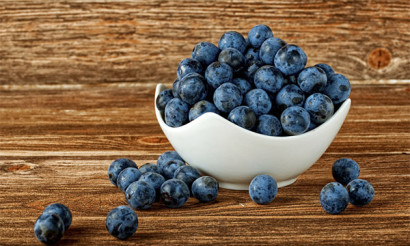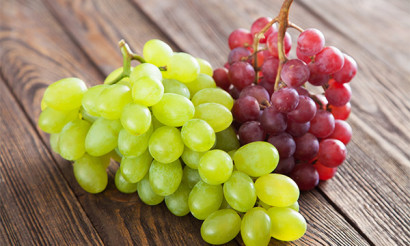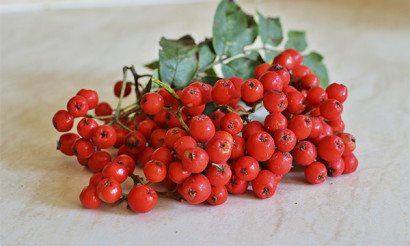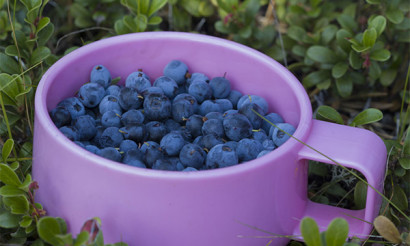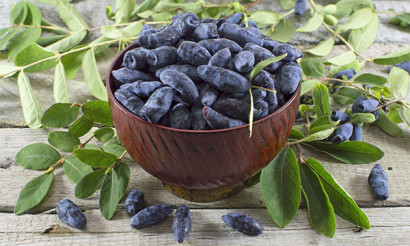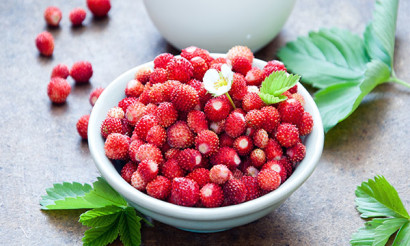Barberry: benefits and harms to human health
Barberry is a plant from the Barberry family, which includes many other shrubs. Many gardeners love it, it is often used for decorative purposes, but at the same time it has a number of useful properties for the human body. This is the reason for the use of these berries in traditional medicine, cooking and cosmetology.
- What does barberry look like
- Kinds
- What is different from dogwood
- Composition and calorie content
- Useful properties of barberry
- General benefit
- For women
- For men
- During pregnancy
- When breastfeeding
- For kids
- When losing weight
- What is the use of dried barberry
- How to dry
- Tea with barberry: benefits and harms
- How to brew
- The benefits of different parts of barberry
- Root
- Bark
- Leaves
- Flowers
- The use of barberry in traditional medicine
- Barberry in cosmetology
- Cooking Application
- Harm and contraindications
- When to collect and how to store barberry
- Is it possible to freeze
- What can be prepared from barberry: recipes
- Compote
- Jam
- Tincture
- Wine
- Interesting facts about barberry
What does barberry look like
Barberry is a thorny bush, reaching 2-3 m in height. The leaves of the plant are ellipsoid in shape, have dimensions 2.5x4.5 cm, and rather large spikes are present on the trunk. Due to its unusual appearance, barberry is often used by site owners as an impregnable “fence”.
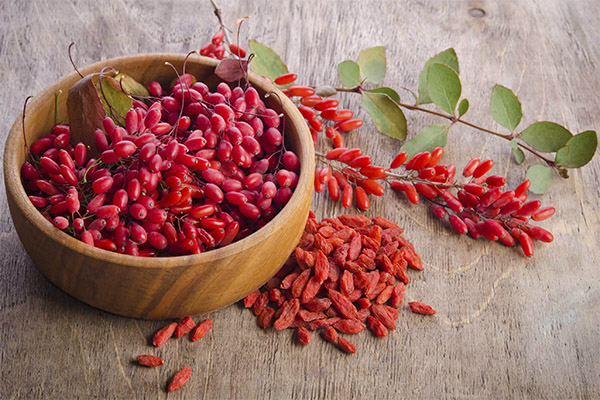
Barberry blooms in spring for two weeks, its yellow flowers serve as a source for bees to obtain aromatic nectar. The shrubs themselves can grow quite widely, but in order to give a neat appearance, they are cut to the desired shape. The roots of barberry are located in the upper soil layer and grow widely due to their "creep".
The berries have an elongated, barrel-shaped and rich scarlet color. One berry weighs about 4 g. Harvest ripens in early autumn, and ripe berries are very useful. Unripe fruits are strictly forbidden to be eaten, as they contain a large amount of alkaloids - substances classified as poisonous.
Kinds
Barberry is a shrub plant that has a wide variety of species. Each summer resident will be able to find for himself exactly the variety that is ideal for his site. Consider the most popular types of this plant today:
- Ordinary - the most common type of shrub from the barberry family. It can be found in southern Russia, as well as in the Caucasus and some other areas of hilly, forest-steppe terrain. Barberry ordinary can grow up to 3 m, on its trunk there are thorns, leaves are rounded, green and red. Flowering of this type of shrub occurs in late spring, and the crop ripens by early fall.
- Tunberg is the second most popular type of barberry, which is distinguished by its unpretentiousness. For this quality, it was loved by many homeowners who use Tunberg barberry for decorative purposes. It can grow widely, so it needs to be trimmed periodically. The trunk and stems have spiky, fairly dense thorns, the leaves are oval, pointed to the end, green or dark red. The fruits of this variety of barberry shrub are harvested in September.
- Amursky is a fairly common type of shrub that looks very much like an ordinary one. It is a tall and wide bush with spikes on the stem and green leaves. In autumn, he changes color to bright orange, which, together with the scarlet fruits, looks simply fabulous. Amur barberry does not require special care, is resistant to temperature fluctuations, and is also great for creating a live fence on the site.
- Harlequin - a barberry bush, which is one of the most moody. It grows very slowly and only on alkaline and neutral soils, does not tolerate freezing. However, outwardly Harlequin looks very beautiful: bright leaves with white spots, yellow flowers and red berries.This barberry blooms luxuriantly and brightly, mainly in May-June, and the fruits ripen in September.
- Cabernet is a type of barberry that grows in sunny areas in well-moistened soil. This shrub is quite low (about 1 m in height), has thorns on the trunk and stems, green, yellow and red leaves and red fruits. Barberry Cabernet does not tolerate frost and drought, it also needs to be trimmed regularly.
Of course, in nature there are much more species of barberry, including those bred by breeders, here are only the most common of them.
What is different from dogwood
Barberry and dogwood are easily confused, since both shrubs have a similar appearance and fruit. However, if you know the main differences between these plants, they can still be distinguished:
- Dogwood has a red-brown bark, while barberry has a yellow-brown.
- Dogwood leaves are larger than that of barberry.
- Dogwood blooms in late March, barberry in May-June.
- The fruits of dogwood have a burgundy, almost black color, and the berries of barberry are bright red.
- Dogwood contains one large bone, barberry - several small.
The rest of the plants are very similar to each other. In addition, in many ways the methods of using these berries in traditional medicine and cooking coincide.
Composition and calorie content
Barberry has a unique chemical composition and, as a result, medicinal properties. The main active ingredient in this berry is barberine, in addition to it, the fruits contain palmitin, berberrubin, essential oils, flavonoids, pectin, vitamins C, E, P, B1, B2, BB, ascorbic, tartaric and citric acid, valuable oils (in seeds ), as well as glucose and fructose. At the same time, the energy value of barberry is low - only 30 kcal per 100 g.
Useful properties of barberry
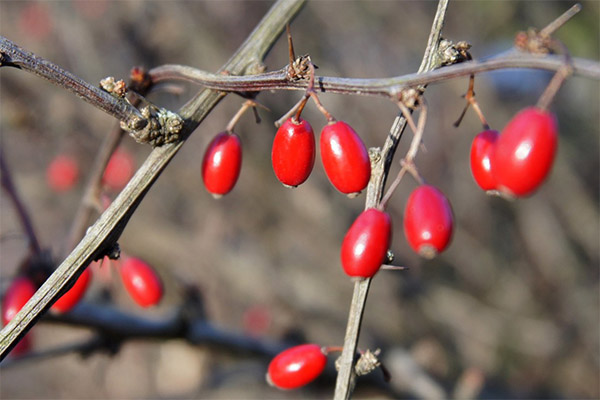
General benefit
The chemical elements that make up barberry have a number of useful properties for the human body. So, the berries are endowed with a calming, anti-inflammatory, bactericidal, antioxidant, restorative and even anti-cancer effect. Back in ancient India and Egypt, barberry was used by well-known healers and priests to treat a number of diseases. It is also known that this berry was recommended for the treatment of ulcers and the withdrawal of Avicenna bile. In the Middle Ages, drugs were made on the basis of barberry for the treatment of hepatitis, scurvy and vitamin deficiency. To date, the plant in question has not lost its relevance - its fruits are used to overcome a number of diseases.
For women
Barberry fruits, leaves and other parts of the plant are useful for women, primarily because they have an analgesic effect. This allows you to relieve unpleasant sensations during menstruation, and the berry is also able to stop heavy blood loss. The leaves and fruits of barberry can be brewed as tea and consumed for weight loss. Regular eating of the fruits of this plant allows you to maintain health, and also maintains youth and beauty of the skin, hair and nails.
For men
The fruits of barberry have a positive effect on men's health - they increase potency, help in the fight against diseases of the genitourinary system, and also support the body with intense physical and mental stress. Decoctions of barberry are indicated for use in sprains and other injuries, as well as inflammatory diseases.
During pregnancy
Despite all its usefulness, the berries and leaves of this plant are not recommended for pregnant women. This is due, first of all, to the high allergenicity of the fruits, as well as to the fact that barberry contains alkaloids - substances that can negatively affect the well-being of a pregnant woman and even provoke a miscarriage. Thus, berries are dangerous during pregnancy, which means that their use should be avoided.
When breastfeeding
Nursing women should not eat barberry, both the fruits themselves and decoctions from the leaves and roots of the plant. This is due, firstly, to the fact that barberry has a high degree of allergenicity, and secondly, this plant helps to eliminate fluid from the body, which can negatively affect the amount of milk.
For kids
Berries of barberry are quite allergenic, in connection with which they can be included in the children's diet only after 12 years. But if it becomes necessary to treat certain diseases in which the use of barberry is required, then its administration is allowed, but in strictly limited quantities and only after the reaction of the body is checked. So, barberry is indicated for children with diabetes, as a means of quickly lowering blood sugar levels. It is also recommended to eat berries to frequently ill children with reduced immunity.
When losing weight
In the struggle for a slim figure, women are ready for almost anything. But for weight loss, it is not necessary to exhaust the body with prolonged hunger strikes or use dubious drugs. You can become slimmer by including in your diet foods that contribute to fat burning, one of which is barberry. These berries are able to increase the metabolic rate, and therefore they are often compared with Goji. Both those and others improve the digestion process, have a choleretic effect, contribute to the removal of excess fluid from the body.
Those who want to lose weight are advised to eat 100-200 g of berries per day. Barberry is a low-calorie product, in a 200-gram serving contains only 60 kcal. At the same time, they will be an excellent substitute for sweets or additions to various dishes, not only desserts, but also meat, fish, vegetables.
For weight loss it is useful to drink tea from barberry. To do this, take 0.5 tbsp. dry crushed leaves of barberry, pour a glass of boiling water and insist for half an hour. Divide the resulting drink into 3 servings and drink it during the day after the main meals.
What is the use of dried barberry
Dried barberry fruits have many valuable properties. Even in ancient times, this product was used by traditional healers to treat diseases of the digestive tract, liver, kidneys, heart and blood vessels, as well as to increase immunity and as a sedative.
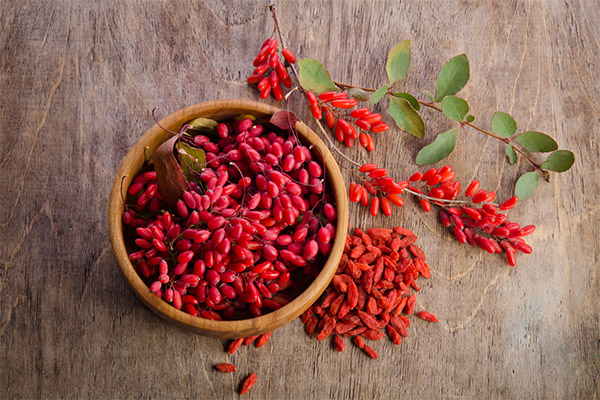
Dried barberry will be an excellent addition to tea, without causing an increase in weight, because 100 g contains only about 150 kcal. These dried fruits are indicated for use by diabetics, as they help reduce blood sugar.
How to dry
In order to cook independently dried barberry, first of all, it is necessary to choose ripe fruits. Most varieties of this plant ripen in early autumn, but you need to harvest before the first frost. After the berries are picked, they must be sorted out by removing twigs, leaves and spoiled specimens, then washed and dried. After spreading a thin layer of barberry on a baking sheet, turn on the oven at 45-50 degrees and hold for about 30 minutes. Then raise the temperature to 60 degrees and leave the berries until tender.
Completely dry fruits have a wrinkled appearance, their color becomes darker, and when pressed, juice does not stand out. Finished dried fruits need to be laid out in glass jars or sealed bags, they can be stored for one year.
Tea with barberry: benefits and harms
Barberry tea has a slight acidity and a pleasant aroma. The benefits of tea from this plant is that it helps fight colds, digestive upsets, insomnia and impaired appetite. Also, this drink is indicated for kidney and liver diseases.
If we talk about the dangers of barberry tea, it can be noted that it negatively affects health only with excessive consumption. It is also not recommended to use this drink for pregnant, lactating women and children under the age of 12 years. In other cases, tea from barberry will only benefit the human body.
How to brew
There are several recipes for brewing barberry tea. Some of them suggest the addition of other herbs, which only increases the value of the drink. Consider the most effective barberry tea recipes that have been passed down from generation to generation for several centuries.
- Soothing tea: mix 1 tbsp.dried leaves of barberry, wild strawberry and lemon balm, pour 750 ml of boiling water, leave for 30 minutes, then strain. Ready-to-drink drink 200 ml twice a day for sleep disturbances, increased anxiety and stress.
- Prescription tonic tea: 1 tbsp. dried barberries must be filled with 200 ml of boiling water and insist 15-20 minutes. Drink half a cup 2-3 times a day to increase immunity, health and overall well-being.
- From digestive upset: in equal proportions mix dried barberry, fennel, caraway seeds and motherwort, take 1 tbsp. mixture and pour 250 ml of boiling water. After 30 minutes, filter, divide into 3 doses and drink during the day after a meal.
The benefits of different parts of barberry
For therapeutic and preventive purposes, not only the fruits of barberry are used, but also leaves, stems, flowers, as well as roots. Each part of the plant has a certain positive effect and is used to prepare various medicines.
Root
For the treatment of inflammatory diseases of the oral cavity, a decoction of barberry root is used. You need to cook it as follows: pour a pinch of dry crushed root of the plant with boiling water (200 ml) and insist for 15 minutes. After this, strain the broth, divide into 3 parts and consume during the day. You can use the resulting broth to relieve pain and discomfort in the oral cavity.
Bark
From the barberry bark, a tincture is prepared to help with diseases such as cholecystitis, hepatitis, inflammation of the kidneys and bladder. 2 tbsp barberry bark pour 400 ml of boiling water, leave for 4 hours and strain. You need to take tincture 100 ml 3-4 times a day.
Leaves
Decoctions and teas are prepared from barberry leaves to help with colds and viral diseases, coughs and sore throats. To prepare a therapeutic drink you need to take 1 tbsp. dry crushed leaves of barberry, pour a glass of boiling water, leave for 30 minutes and strain. Drink tea in a warm form, half a cup 3 times a day.
Flowers
From the flowers of barberry, a fragrant and bright tea is obtained, which is a general strengthening agent, and also helps with insomnia, stress and nervous strain. Tea is prepared as follows: 1 tbsp. dried barberry flowers pour 200 ml of boiling water, insist for 15 minutes and drink during the day, divided into 3 doses.
The use of barberry in traditional medicine
Barberry is widely used in folk medicine. Berries and other parts of this shrub are used to treat a wide range of diseases, including diabetes mellitus, gout, inflammation of the kidneys, gall bladder pathology, digestive upset, colds, sleep disorders, appetite, nervous strain, etc.
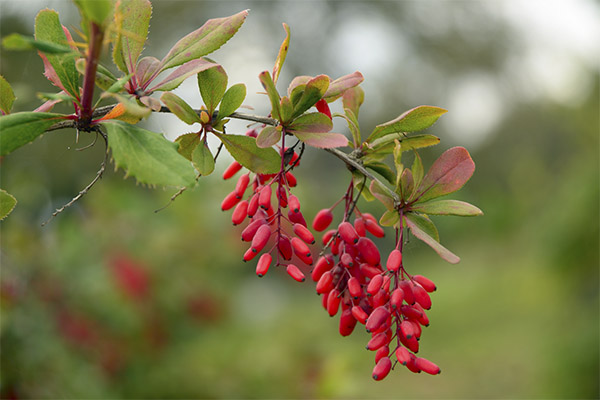
This plant helps to prolong youthfulness, and also acts as a general strengthening agent, restoring strength and improving well-being. However, in its use it is important to observe reasonable standards, since an overdose of certain substances, for example, the alkaloids that make up this plant, can cause various complications.
Barberry in cosmetology
Despite the huge selection of cosmetics in modern stores, many women use folk beauty secrets. So, berries and leaves of barberry are widely used in cosmetology. This plant is known for its anti-aging, tonic, anti-inflammatory properties, with its help it is possible to eliminate age spots, acne and small wrinkles. Consider the most effective cosmetics based on barberry.
- Decoction of barberry berries: 1 tbsp. dry leaves of the plant pour a glass of boiling water, insist for half an hour and strain.Rinse hair with this broth after each wash, and also rub into the scalp to get rid of dandruff and a feeling of dryness.
- Means for skin elasticity and youth: 2 tbsp. Dried fruit pour a glass of boiling water and insist for an hour. The resulting infusion can be used to wipe the skin of the face and body, it gives elasticity. Such a natural lotion eliminates age-related changes, as well as reduces the appearance of freckles and age spots, whitening the skin.
- Home-made barberry oil against rashes and to increase skin tone: you need to take crushed barberry and vegetable refined oil in equal proportions, mix with each other and leave for 5 days to insist. After that, apply the oil for cosmetic purposes. It must be rubbed into the skin in order to reduce wrinkles, as well as reduce the appearance of pigmentation, manifestations of cellulite and sagging. To achieve a visible effect, you need to use the oil daily for 4 weeks, and after a month break, repeat the course.
Cooking Application
Berries of barberry have an unusual taste and aroma. They are quite tasty, and therefore widely used in cooking. The most common methods for harvesting barberry are jam, compotes and dried fruits.
Due to the neutrality of taste, barberry is added not only to desserts, but also meat, fish and vegetable dishes. Real foodies will appreciate the following barberry recipes:
- Sweet and sour sauce for meat and fish dishes. To prepare this incredibly delicious Caucasian addition to the main dish, you will need the following ingredients: a glass of barberry, 2 cloves of garlic, a pinch of red pepper, dill, coriander and salt. First you need to boil the berries for 15-20 minutes, then add all the other ingredients and beat with a blender. The resulting sauce can be used for its intended purpose - as an additive to pilaf, kebab, steak, ribs, fish, chicken wings and much more.
- Soup with beef and barberry. An excellent dietary option for the first course, which you can eat even losing weight. To prepare it, you need to take 1.5 liters of water, 150 g of lean beef, one medium potato, 1 tomato, half an average onion, 50 g of berries of barberry, salt and a little fresh cilantro. Beef should be cut into cubes, add water and cook for 20 minutes. Then add chopped potatoes in small cubes, and finely chopped onions and peeled tomatoes (for convenience, can be scalded with boiling water) and fry in a pan with a small piece of butter. Add the vegetables to the soup, boil for 10 minutes, then add the barberry and leave the soup on the fire for another 10 minutes. Add fresh chopped cilantro to the finished dish. Such a soup will not only not harm the figure, but will also replenish the body's reserves of vitamins and minerals, and will also surprise you with its unusual taste.
- To harvest barberry jelly for the winter, 1 kg of berries, as much sugar and a glass of water will be required. Berries must be washed, put on fire and cook until soft. After wipe the berry mass through a sieve. Add sugar and boil. The jelly is ready, it remains only to pour it into pre-sterilized jars and close the lids. Such a dessert is stored for 1-2 years without losing the bulk of the beneficial properties of barberry berries.
Harm and contraindications
Almost any product can bring both benefit and harm, which applies to barberry. In order to avoid problems in the form of allergies and side effects, it is important to consider the following rules for consuming this berry:
- You can eat only ripe barberry, as unripe berries contain toxic substances.
- Barberry should be eaten in moderation - 100-150 g per day, otherwise the risk of allergies and oversaturation of the body with some substances that make up the berry increases.
- Barberry should not be used during pregnancy and during breastfeeding, this berry is also contraindicated in children under 6, and in some cases up to 12 years.
- In the presence of serious health problems in which the use of barberry causes doubt in the patient, it is necessary to obtain medical advice.
When to collect and how to store barberry
Most varieties of barberry ripen in early autumn, a smaller part in late August. Harvest should only be when the berry is fully ripe. Barberry is removed from the branches in household gloves, as this shrub can easily injure its hands with its sharp spikes. It is better to put the berries in baskets or wide basins so that they do not crumple.
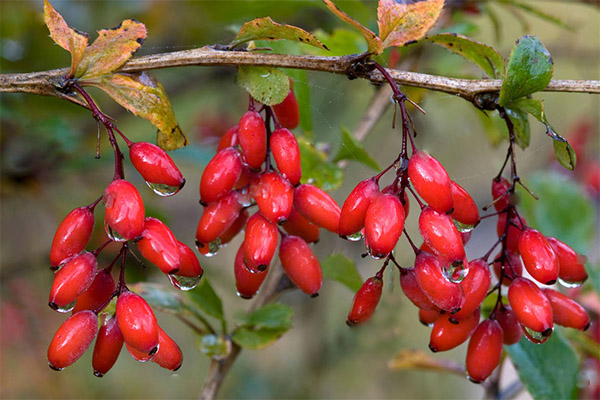
Barberry is not stored fresh for long - just a few days at room temperature and up to 2 weeks in the refrigerator. To preserve valuable fruits for a longer period, they can be dried, frozen, boiled compote, jam or make wine. Berry blanks are stored in a dry, dark place for 1 to 2 years, depending on the method of harvesting.
Is it possible to freeze
Barberry can be frozen, thereby preserving the crop until next year. For freezing, the berries are washed, dried and distributed in portioned packets or containers, and then placed in the freezer. You can store frozen barberry for 1-2 years.
What can be prepared from barberry: recipes
From the fruits of the barberry tree, you can prepare such preparations as jam, compote, tincture and wine. All this will help preserve the harvest for a whole year or even two. Consider the classic recipes of the listed methods for harvesting barberry:
Compote
The most delicious barberry compote is obtained by adding a few apples to it. To make such a drink you will need 300 g of berries, 500 g of apples (preferably a sweet variety), 350 g of sugar and a liter of water. The apples must be cut into slices, removing the core, add the washed berries of barberry to them, put it all in a jar and pour sugar syrup (mix the amount of sugar in the recipe with water and boil over low heat until bubbles appear). Then sterilize the container with compote for 15–20 minutes in a large pot of boiling water and close the lids.
Jam
To make barberry jam, you need to take in equal proportions berries, sugar and water. To start, sort and wash the berries, fill them with water and leave to soak for 5-6 hours. While the berries are insisting, boil the syrup: mix sugar with water and hold over medium heat until sugar is completely dissolved and bubbles appear. After that, add the berries to the syrup, boil until the berries are at the bottom. Pour the finished jam into clean, sterilized glass jars and cork.
Tincture
Barberry tincture is prepared according to the following recipe: 3 tbsp. pour 1 liter of vodka, alcohol (45 degrees) or moonshine, add sugar or honey to taste. Put the container in a dark place for 10-12 days. In this case, the contents must be mixed for every 3 days. Filter the tincture and use it for medicinal purposes for 1-2 tbsp. 3 times a day.
Wine
Wine from barberry not only perfectly complements the dinner, but also serves as an anti-inflammatory, choleretic agent. It is not difficult to cook it, if you adopt the following recipe: sort 3 kg of berries, but do not wash, place in a clean container for making wine, pour 2 kg of sugar, add 12 l of boiled cold water to all this. Then close the container with a lid in which to pierce the hole and insert the plastic tube, lowering the other end into another container filled with water.The wine should ferment for about 20–25 days, but if you wish, you can strain it and leave it for another time for aging. Barberry wine is a very tasty and healthy drink that contains 11–13 degrees of alcohol and a large amount of vitamins.
Interesting facts about barberry
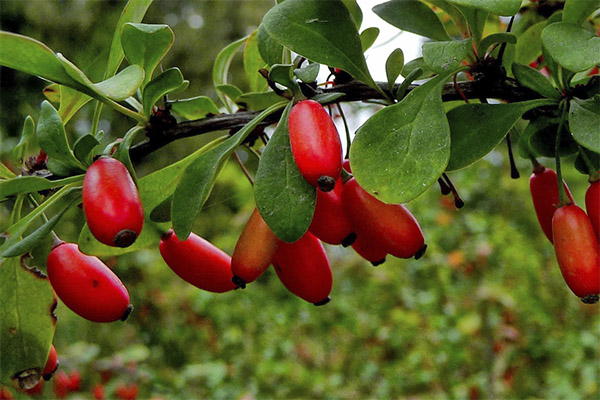
- Barberry began to be called so due to the unusual shape of its flowers: from the Arabic, "baby" means "petals similar to sea shells."
- In some US states, barberry cultivation is prohibited by law. This is due to the fact that this shrub grows too much and can harm other plants and buildings.
- The first mention of barberry found by archaeologists dates back to 650 BC. e. This is evidenced by clay tablets from the library of the Assyrian king.
- The composition of barberry includes the same substances that are contained in the well-known drug to increase the potency of Viagra.
«Important: all information on the site is provided exclusively in fact-finding purposes. Before applying any recommendations, consult with a profile specialist. Neither the editors nor the authors are liable for any possible harm caused materials. "

